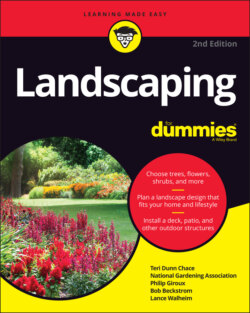Читать книгу Landscaping For Dummies - Lance Walheim - Страница 99
Understanding challenges unique to installing retaining walls
ОглавлениеBe prepared to contend with these major issues when you’re installing retaining walls (they’re certainly not deal-breakers when your wall is 3 feet (.9 m) or less):
It’s hard work. Even for a wall of low height, you have to dig a lot. Depending on the materials you choose, you’ll also be doing heavy lifting and maneuvering — all the more so if you plan several successive ones, that is, if you’re terracing a slope (see the nearby sidebar about terracing).TERRACING DEMYSTIFIEDTerracing is a great solution for turning an otherwise unusable or difficult-to-landscape slope or hillside into garden space. Just fill the completed terraces with soil and plant away. Or, customize the soil in each one — we’ve seen some great rock gardens on this plan. (For rock-garden information, turn to Chapter 20.) Because you’d still be scrambling up and down a hillside to care for whatever plants you install, we recommend low-maintenance choices. Check the color insert for a photograph of how one homeowner worked terracing into their landscape.Remember: One 3-foot (.9 m) retaining wall is a retaining wall; installing a succession of two or more is basically terracing. It’s the same project as the ones we describe in the section, “Working with Slopes,” in this chapter, just bigger. You’ll do more measuring, more excavating, devote more time, and spend more money on materials.Before you start the project, you need to establish a plan that accommodates two things:Rise (the height you want your project to climb/occupy)Run (the length, measured from the highest point to the lowest — the horizontal distance)This basic information will determine how many terraced beds you’re going to need.After doing that, it’s just math. Decide how long each of your beds will be, say, for example, 10 feet (3 m). Divide by the total run (say, 50 feet, 15.2 m), so you need five beds: 50 divided by 10 = 5 (or 15.2 divided by 3 = 5).When the rise is greater than your height, measure the hillside in increments.Start work from the bottom, trenching and building as you work your way up the hill. The back of the last bed should be as high as the front wall of the first bed.If you plan to stabilize your wall with deadmen (horizontal braces; refer to the nearby sidebar about jargon), you’ll need additionally to create trenches every 4 feet (1.2 m), perpendicular to the wall, to accommodate them. One item that makes the work easier and faster is a tamping machine that you can rent. A tamping machine smooths out and compacts the soil surface so it’s as solid and level as possible, without ruts or air pockets; a minimum of two or three passes over a project area is recommended. Follow all instructions about operation and safety.
Get cleared for takeoff. Make sure the project area doesn’t have any underground pipes or buried cables. If there’s any chance there’s natural-gas lines, call your utility company so they can come out and check, and mark spots to avoid — a free service. To make sure, call 811, a nationwide service that checks for utility lines.
Water can ruin your wall. You must install provisions for drainage in order to prevent water from saturating the soil behind your retaining wall and exerting pressure on it, which can destabilize it or move it or parts of it out of position — a snafu you want to avoid.To do so, either create weep holes (holes or gaps that allow drainage) or install a perforated drainpipe (perforated, to facilitate absorption and drainage). Working and backfilling with stones will also help stabilize the project. (You know the neighbor’s wall that’s falling down? We wager that if you look for weep holes, you won’t find them.)
